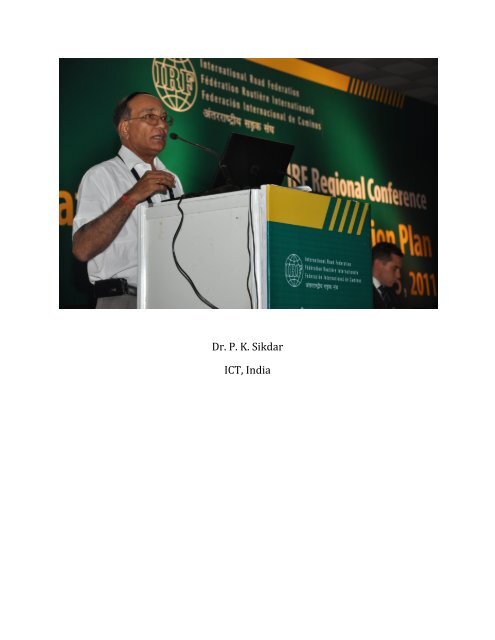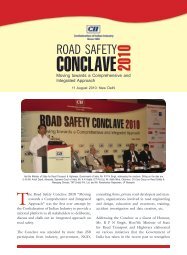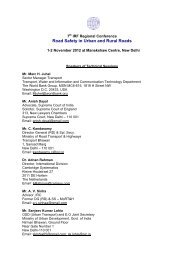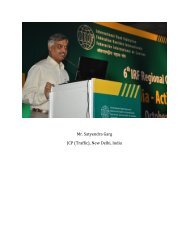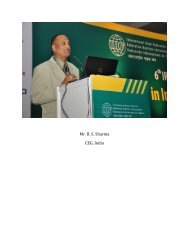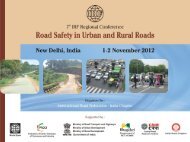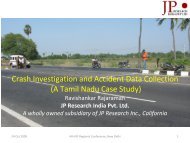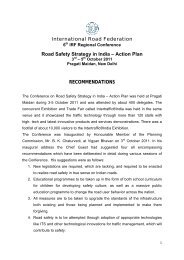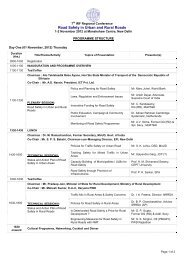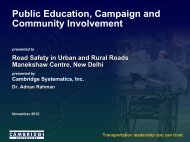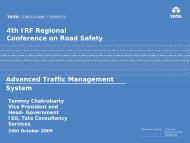Dr. P. K. Sikdar ICT, India - IRF India chapter
Dr. P. K. Sikdar ICT, India - IRF India chapter
Dr. P. K. Sikdar ICT, India - IRF India chapter
Create successful ePaper yourself
Turn your PDF publications into a flip-book with our unique Google optimized e-Paper software.
<strong>Dr</strong>. P. K. <strong>Sikdar</strong><br />
<strong>ICT</strong>, <strong>India</strong>
IN-BUILT ROAD SAFETY<br />
THROUGH PLANNING AND<br />
DESIGN<br />
<strong>IRF</strong> Regional<br />
Conference 2011<br />
<strong>Dr</strong>. P K <strong>Sikdar</strong>, Intercontinental Consultants & Technocrats<br />
Pvt. Ltd, New Delhi
<strong>India</strong>, facts….<br />
125 th in terms of motor vehicles ownership, 15 veh. per 1000 people<br />
2 nd largest road network in the world, 4.2mn km<br />
1%<br />
10%<br />
of world’s motor vehicle population, 125mn<br />
of world’s road fatalities<br />
1 st in number of road fatalities, 127,000 per year<br />
2
Trend in Motor Vehicle Population and<br />
Road Fatalities<br />
140000<br />
140000<br />
120000<br />
100000<br />
80000<br />
60000<br />
40000<br />
20000<br />
8%<br />
120000<br />
100000<br />
80000<br />
5%<br />
60000<br />
40000<br />
Fatalities due to<br />
Road Accidents (in<br />
mbers)<br />
Registered Motor Vehicles (in '000)<br />
Fatalities<br />
nu<br />
Motor Vehicles<br />
20000<br />
0<br />
0<br />
1970<br />
1972<br />
1974<br />
1976<br />
1978<br />
1980<br />
1982<br />
1984<br />
1986<br />
1988<br />
1990<br />
1992<br />
1994<br />
1996<br />
1998<br />
2000<br />
2002<br />
2004<br />
2006<br />
2008<br />
2010<br />
Year 3
Share of Vehicles in Vehicle Population<br />
and Fatalities<br />
Share in No. of Fatalities<br />
Share in Total No. of Vehicles<br />
72%<br />
22%<br />
16%<br />
13%<br />
13%<br />
5%<br />
10%<br />
1%<br />
Motor Cycles, Scooters Cars,Taxies Trucks Buses<br />
4
Fatalities by road user type<br />
Non-motorized<br />
vehicles & other<br />
objects<br />
Sae Share of VRUs VUs – 54%<br />
Other Motor<br />
13%<br />
Pedestrians<br />
13%<br />
Vehicles<br />
9% Two Wheelers<br />
22%<br />
Trucks<br />
11%<br />
Auto Rickshaws<br />
6%<br />
Bicycles<br />
Car, Taxis etc.<br />
Buses<br />
6%<br />
13%<br />
7%<br />
5
Causes of Road Accidents<br />
Often it is stated that,<br />
“Over 80% of road accidents are due to Road Users’ Fault”<br />
It is probably not correct !!!!<br />
82%<br />
76% No. of Accidents No. of Fatalities<br />
14%<br />
19%<br />
2% 3% 1% 2% 1%<br />
1%<br />
Road User's Fault Defect in Condition<br />
of Motor Vehicle<br />
Defect in Road<br />
Condition<br />
Weather Condition All Other Causes<br />
6
Deficient Road Accident Data Collection<br />
System<br />
Presently the road accident data is collected by Police<br />
officers and recorded d in the form of FIR (First<br />
Information Report), which is a crime record and NOT<br />
accident data<br />
No investigation possible using this data to ascertain<br />
the cause of accident<br />
An <strong>IRF</strong> initiative using CSR funding from corporate<br />
world has developed RADaR, which will address this<br />
issue<br />
7
What is the reason for huge number of<br />
road fatalities?<br />
High growth in number of vehicles over past few<br />
decades? d Yes, but up to certain extent<br />
No commensurate improvement in the road network<br />
efficiency i or its management<br />
Rampant violation of traffic rules, as enforcement is<br />
primitive and without motivation<br />
Extremely poor road use behaviour in all types of<br />
road users<br />
Of course, the roads are not forgiving, and errant<br />
drivers are punished with death<br />
8
Giant Road Development<br />
Programs in Idi <strong>India</strong>
Giant Road Development Programs in <strong>India</strong><br />
NHDP – National Highway Development Project<br />
PMGSY – Pi Prime Minister’s Miit Rural Road Development<br />
Project<br />
SRDPs – State Road Development Programs<br />
Urban Transport Projects<br />
NHDP being implemented by NHAI with long term<br />
objective of connecting the country together through<br />
arterial network of high class four/six-lane highways<br />
NHDP started with two main phases, which is now been<br />
extended to an ambitious plan of seven phases<br />
10
11<br />
11
12<br />
12
13<br />
13
14<br />
14
Some of them have glaring g problems
Consistency in Design Essential<br />
16<br />
Improperly designed entry ramp<br />
16
Intersection of village road not<br />
designed for geometry<br />
(… this could be pointed out by audit)<br />
17<br />
17
Geometry for a high speed road!!!<br />
18<br />
18
Geometry for a high speed road!!!<br />
19<br />
19
Level difference between the two carriageways<br />
20<br />
20
Deficient design and Implementation<br />
21<br />
21
Land use close to road: No recovery zone<br />
22<br />
22
Road Development should be parallel to<br />
Safety Initiatives<br />
<strong>India</strong> has experienced tremendous rise (8-10% growth) in<br />
road fatalities<br />
Attention was mainly on the road development, and no<br />
attention has been paid till recently for anything related to<br />
road safety<br />
Government plans to invest US$ 200 billion in the 12 th Five<br />
Year Plan<br />
Higher speeds on NHDP roads have changed the mobility<br />
scenario across the whole country, with consequent<br />
disastrous impact on safety outcomes of the National<br />
Highways<br />
Systematic ti plan and programme required to address the<br />
problem from all angles<br />
23
A Decade of Action for Road Safety…<br />
2011-2020<br />
For reducing the road fatalities for 2020 by<br />
50%, the UN has launched the Decade of Action<br />
Five Pillars,<br />
Road safety management<br />
Safer road design<br />
Safer vehicle design<br />
Safer road users<br />
Post crash care<br />
24
Deficiencies in the current system<br />
of Planning & Designing<br />
i
Planning: Practical Problems<br />
Absence of planning exercise, in true sense<br />
Even if some planning is done, the time allotted is not<br />
sufficient, and that various alternatives are never<br />
evaluated<br />
There are no proper guidelines and standards for<br />
planning as such<br />
Lack of forward thinking; as a result, safety is never<br />
thought ht about at the time of planning<br />
No considerations for communities; adequate public<br />
consultations are not done; and no optioneering is<br />
attempted<br />
26
Planning doesn’t account for,<br />
Land-use planning<br />
Development control and encroachment<br />
Ribbon development<br />
Network hierarchy<br />
Route planning<br />
Access control<br />
27
Road Safety Land-use<br />
Heavy Industry<br />
Manufacturing<br />
Heavy Goods<br />
vehicles<br />
Commercial &<br />
Offices<br />
Residential areas<br />
Light goods<br />
vehicles & cars<br />
Cars, buses,<br />
cycles &<br />
pedestrians<br />
Combination of land-use<br />
generate mix of incompatible<br />
& conflicting traffic<br />
Exposure of<br />
VRUs to high<br />
speed traffic<br />
Mixed traffic<br />
condition of<br />
different speeds<br />
unsafe access<br />
arrangement<br />
Encroachment on<br />
roads and footpaths<br />
28
Land-use Planning Safer Practice<br />
Zoning: e.g. Residential areas shall be separated<br />
from industries i and major commercial areas<br />
Strong planning regulations and their strict<br />
adherence to influence location of new developments<br />
and to control access and parking<br />
Design residential schemes for low speeds and light<br />
vehicles with occasional access to other commercial<br />
vehicles<br />
Incorporate Road Safety in assessing traffic impact<br />
studies of new development<br />
29
Design doesn’t strictly aim for,<br />
Traffic segregation<br />
Traffic calming<br />
Road Safety Audits<br />
Accident investigation & prevention<br />
Even if it is considered, it is removed later just to meet<br />
the objective of financial viability<br />
Did we consider social viability ever ?<br />
Did we ever ensure safety ?<br />
30
Initiatives being taken by Govt.<br />
of <strong>India</strong>
Initiatives of Govt. to Ensure Safety in<br />
Planning & Designing<br />
Issued a circular to all concerned Depts. to implement<br />
the desired d additional engineering i measures both on<br />
existing roads as well as in on-going road projects<br />
Issued instructions ti that t certificate t of compliance to<br />
RSA recommendations will be required for project<br />
approvals<br />
Allocated designated fund for road safety<br />
improvements in existing roads as well as in proposed<br />
projects<br />
These are excellent initiatives….<br />
32
A FIVE-SHOT VACCINATION<br />
PLAN
Diagnosis:<br />
Planning and design ills<br />
Update Standards<br />
d 1<br />
& Guidelines<br />
Stop Compromising<br />
2<br />
Vaccines for<br />
Safer Roads<br />
Time for Planning &<br />
Design<br />
3<br />
Defuse the Time<br />
Bomb by RSA<br />
Accountability<br />
4<br />
5<br />
34<br />
34
1<br />
UPDATE STANDARDS & GUIDELINES<br />
The standards & guidelines are to be updated so<br />
that safety is duly incorporated into the road<br />
design<br />
Standards & guidelines to be updated regularly for<br />
improving them based on experience about their<br />
performance<br />
This experience may be collected from around the<br />
world<br />
DO SOME RESEARCH !!! Standards are to be updated<br />
based on research findings<br />
Review and upgrade planning/design codes and<br />
guidelines for roads, with focus on road safety<br />
35
2<br />
STOP COMPROMISING<br />
Generally to implement the ambitious road<br />
development plans in a tight time-frame, safety<br />
features are compromised<br />
Road design shall incorporate all required safety<br />
features such as,<br />
Low-cost measures, e.g. signing, marking, delineation, etc.<br />
Medium-cost measures, e.g. bus stop bays, separate pedestrian<br />
sidewalks, truck laybys, rumble strips on shoulders and<br />
centerlines, etc.<br />
High-cost measures, e.g. service roads, dedicated lanes for<br />
VRUs, grade separation, pedestrian overpasses, etc.<br />
36
2<br />
STOP COMPROMISING<br />
An uncompromised VRU-centric design and its<br />
implementation ti will itself save lives of many VRUs<br />
being killed every year on road<br />
Roads designed d with provision i of all required safety<br />
features shall only be implemented<br />
37
GIVE SUFFICIENT TIME FOR PLANNING &<br />
3 DESIGNING<br />
Roads are generally built without a proper<br />
planning exercise<br />
Planning exercise, if undertaken, is not provided<br />
with sufficient time to evaluate different planning<br />
alternatives<br />
Planning exercise considering all the VRUs in<br />
urban areas is never given due importance<br />
resulting into safety hazard for VRUs<br />
38
GIVE SUFFICIENT TIME FOR PLANNING &<br />
3 DESIGNING<br />
Time given for design is not sufficient – especially<br />
optimization is not possible, interaction/interplay<br />
of design elements never examined<br />
Critical decisions affecting 90% of the project<br />
cost are taken in very little time and with limited<br />
or no choice examined<br />
39
GIVE SUFFICIENT TIME FOR PLANNING &<br />
3 DESIGNING<br />
Mandatory input of Road Safety Engineer at the stage<br />
of planning, i.e. feasibility study, and at all the stages<br />
during design is necessary<br />
Implement FIVE YEAR ROAD PLANS – identify the road<br />
development needs in 5 year blocks in advance, give<br />
6 months for planning, 1.5 yr for feasibility and<br />
detailed design, and 3 yrs for construction<br />
Due and adequate time for planning and design shall<br />
remove many of the design shortcomings<br />
40
4<br />
DEFUSE THE TIME BOMB<br />
ROAD SAFETY AUDIT (RSA): Applying road safety<br />
engineering experience to designs before the roads are<br />
built<br />
RSA is the safety insurance of the roads, an important<br />
input at planning and designing stage<br />
It is like defusing a ‘time bomb’<br />
a principle of ‘prevention is better than cure’ applied in<br />
advance of building roads<br />
Funds to be earmarked for implementing audit<br />
recommendations<br />
The RSA process to be utilized uniformly for all road<br />
projects across the country<br />
41
4<br />
DEFUSE THE TIME BOMB<br />
RSA right from planning<br />
exercise is a must for road<br />
projects. The audit must be<br />
done at different stages,<br />
Feasibility stage<br />
<br />
<br />
<br />
<br />
<br />
Preliminary design<br />
Detailed design<br />
During construction<br />
Constructed (Pre-opening)<br />
Existing roads (monitoring)<br />
Concept<br />
<strong>Dr</strong>aft<br />
Details<br />
Build<br />
Open to Traffic<br />
Feasibility Audit<br />
Preliminary Design<br />
Audit<br />
Detail Design Audit<br />
Construction stage<br />
Audit<br />
Pre-opening Audit<br />
Monitoring Audit<br />
42
5<br />
ACCOUNTABILITY<br />
The design of roads done by technical consultants<br />
never gets checked by Client Agency due to lack<br />
of competence<br />
In case of PPP projects, the entire responsibility of<br />
design is given to the private party, which has far<br />
reaching consequences<br />
Accountability is to be built-in in all planning and<br />
design outputs<br />
43
ACTION PLAN<br />
Organize capacity building programs for the<br />
implementing agencies and road authorities (at the<br />
level of decision makers & policy planners)<br />
Give clear mandate with definite it accountability to<br />
show results based on pre-defined targets<br />
Divide id responsibilities across the organizations<br />
responsible for roads and utilities<br />
Develop and implement Road Safety Action Plan for<br />
each state and district<br />
44
ACTION PLAN<br />
A culture of safety mindedness is required to be<br />
adopted d uniformly all organizations<br />
Planners and designers shall be self conscious about<br />
road safety, for which h training i is required<br />
A process of accounting each and every detail about<br />
safety in planning and designing i is required to be inbuilt<br />
in codes and standards<br />
e.g. at the time of design, the designer shall provide<br />
details of design features, with their safety<br />
consequences (level of potential risk) and measures to<br />
avert the risks<br />
45
IN CONCLUSION<br />
In our current system, the road user is<br />
blamed for his failure to cope with the<br />
road environment (he/she is made<br />
responsible for all safety ills)<br />
Responsibility for the road safety lies with<br />
designer and the road authority. Let them<br />
be responsible<br />
46
IN CONCLUSION<br />
The Vision Zero (in Sweden) explicitly shares<br />
the responsibility between designers and road<br />
user according to the following principles:<br />
The designers are always ultimately responsible for the<br />
design, operation, use of the system, and for the level of safety<br />
within the entire system<br />
Road users are responsible for following the rules for using the<br />
system set by the designers<br />
If road users fail to obey these rules due to lack of<br />
knowledge, acceptance or ability, or if injuries occur, the system<br />
designers are required to take necessary further steps to<br />
counteract people being killed or seriously injured<br />
47
IN CONCLUSION<br />
Let us aim for safer roads through better<br />
planning and design<br />
48
“Knowing is not enough;<br />
we must apply.<br />
Willing is not enough;<br />
we must do.”<br />
- Goethe<br />
T H A N K Y O U<br />
49<br />
pksikdar@ictonline.com<br />
49


